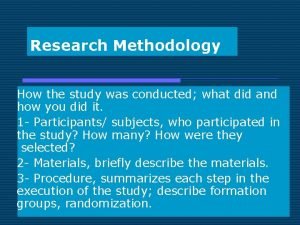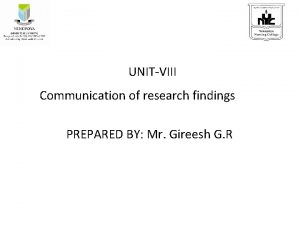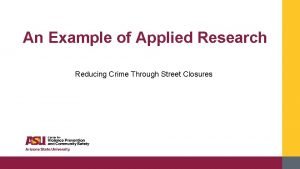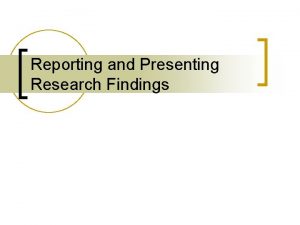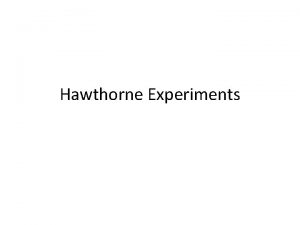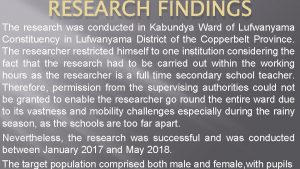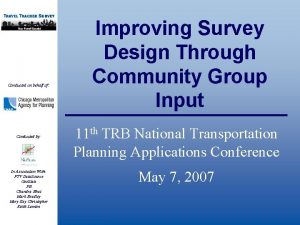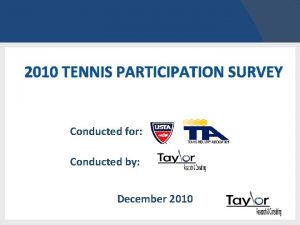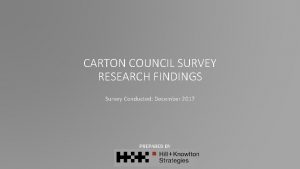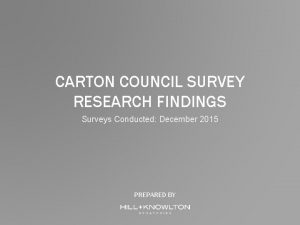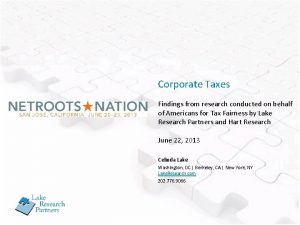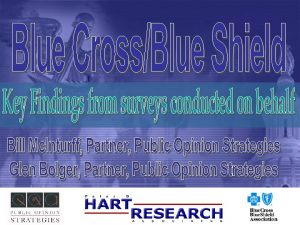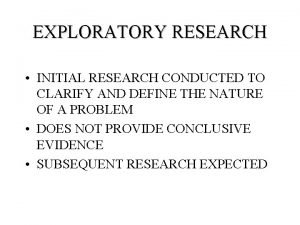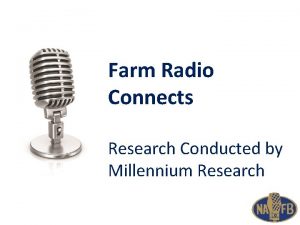RESEARCH FINDINGS The research was conducted in Mpongwe

![Percent (%) distribution of status of pupils [VALU E] Double orphan [VALU E] None Percent (%) distribution of status of pupils [VALU E] Double orphan [VALU E] None](https://slidetodoc.com/presentation_image/4056c48737bf981aa0819572e266689e/image-2.jpg)














- Slides: 16

RESEARCH FINDINGS The research was conducted in Mpongwe constituency of Mpongwe district in Ibenga ward at Ibenga Girls secondary School. The research restricted himself to one institution as he had to do the entire work within the working hours as he is full time secondary school teacher. Hence, it was not going to be possible to seek permission at all times to make rounds in the ward as it too vast and the schools are distanced. However, the research went on well and this was conducted between November 2016 and February 2018. All the targeted pupils were female and their ages ranged between 15 -17 years and all were in Grade 10.
![Percent distribution of status of pupils VALU E Double orphan VALU E None Percent (%) distribution of status of pupils [VALU E] Double orphan [VALU E] None](https://slidetodoc.com/presentation_image/4056c48737bf981aa0819572e266689e/image-2.jpg)
Percent (%) distribution of status of pupils [VALU E] Double orphan [VALU E] None Single The chart indicates that a total of 11 pupils responded to this question and nine (9) indicates that they have both parents alive. One (1) in each case showed that they are either double orphaned or single orphaned. The percentage representations are 9. 09% for both double and single orphans and 81. 82% for those who are neither.

Percent (%) distribution of age of parent 18. 18 9. 09 35 36 37 39 40 9. 09 43 47 48 53 55 This chart shows that the age percentage of the parents for all the parents were even at 9. 09% except for the of 40 years which was 18. 18% giving a number of two respondents who their parents with this age.

Percent (%) distribution of sex of parent/guardian 60 50 40 30 20 10 0 Female Male Six respondents, giving 54. 55%, indicated that their parents were female and 5 respondents giving, 45. 45%, showed that their parents were male.

Percent (%) distribution of the highest level of education of the parent/guardian 18% 64% 18% Primary Secondary Tertiary The pie chart above shows the distribution of the highest of education of the parents that they respondents had provided. The analysis shows that the highest level in tertiary with 64% category and then both primary and secondary levels were equated. At 18% each. Thus, the numbers can summarised as 7 and then 2 apiece for the respondents with parents with tertiary, secondary and primary levels respectively.

45. 45 50 45 40 35 30 25 20 18. 18 9. 09 15 10 5 0 Percent (%) distribution of main profession of the household Business Civil head servantoff Farmer Other Private sector employee The 3 -D chart above highlights the main profession of the head of the household with the highest under the civil service.

Percent (%) distribution of household demographics - females Percent (%) distribution of household demoraphics - males 30 p e rc e nt a g e 25 20 15 10 5 0 0 1 2 3 4 frequency 5 6 7 P e r c e n t a g e 30 25 20 15 10 5 0 3 3 2 2 1 frequency The two charts above summarise the numbers of both females and males that are present in each household as given by the respondents.

FREQUENCY PERCENTAGE Accessible 5 45. 45 Very accessible 6 54. 55 Yes 7 63. 64 No 4 36. 36 Not far 7 63. 64 Quite far 4 36. 36 ACCESSIBILITY OF EDUCATION (SCHOOLS) SUFFICIENT NUMBER OF SCHOOLS DISTANCE TO SCHOOL The table above highlights the responses on the accessibility of education and this indicates that 5 respondents said that schools in Ibenga ward were accessible and 6 showed that schools very accessible giving the percentage distribution of 45. 45% and 54. 55 respectively. The table also summarises the sufficient number of schools in the area and this is indicated by 8 respondents giving a ‘yes’ and 3 saying ‘no’ with 63. 64% and 36. 36% in that order. Equally, the distance to school is indicated by choices of ‘not far’ and ‘quite far’ showing that 7 respondents said that their school was not far and 4 said that this was quite far with the percentage distribution of 63. 64% and 36. 36% respectively.

FREQUENCY PERCENTAGE Bus/Car 1 9. 09 Walking 9 81. 82 Cycling 1 9. 09 Sometimes 1 9. 09 Often 1 9. 09 Very often 9 81. 82 MODE OF TRANSPORT ATTENDANCE OF SCHOOL The table above shows the mode of transport and the attendance of school by the day scholars at Ibenga Girls Secondary School who were targeted for the study.

FREQUENCY PERCENTAGE 11 100 Yes 8 72. 73 No 3 27. 27 SCHOOL FEES PAID ZMK 500 - 1000 DO YOUR PARENTS MANAGE TO PAY SCHOOL FEES The table shows the amount of fees that the respondents paid and if their parents manage to pay these fees. The summary of the findings are that all the respondents paid their school fees between Five hundred and one thousand Zambian kwacha (ZMK 500 – 1000). The other highlight is that eight (8) of the respondents said that their parents manage to pay school fees and three (3) indicated that their parents do not manage to pay the school fees. The percentage representations of this data is that the range in which the school fees were paid is 100%. 72. 73% shows that parents manage to pay school fees and 27. 27% indicate that parents do not manage to pay school fees.

Percent (%) distribution of populuation density 60 50 40 30 20 10 0 High Low Medium The area chart above shows that twenty two (22) respondents indicated that the population density of Ibenga ward was high and this is given by the percentage mark of 55%. One (1) respondent indicated that the population density was low and this gives a percentage of 2. 5%. Seventeen respondents said that the population density in Ibenga ward was medium and this is shown by the percentage of 42. 5%.

Percent (%) distribution of specialisation of teachers 5% 3% 3% 13% 5% 5% 5% 3% 10% 8% 3% 3% Biology and Chemistry Business studies Civic Education and History Computer Studies English and Geography English and HIstory English and Library Studies English and Religious Education French Geography and History and Geography Home Economics Mathematics and Biology Physics and Chemistry Religious Education and Civic Education Religious Education and History Science The pie chart above summarises the qualifications of the respondents that participated in the study.

PERCENT (%) DISTRIBUTION OF HIGHEST LEVEL OF EDUCATION 50 40 30 20 10 0 0 0. 5 1 1. 5 2 2. 5 3 3. 5 The scatter plot above summarises the highest qualifications of the respondents and this shows that two respondents had a masters degree giving 5%, nineteen had secondary degrees and secondary diplomas giving 47. 5% respectively.

FREQUENC Y PERCENTAGE Yes 40 100 Computer data entry 1 2. 5 Computerised 1 2. 5 Electronic 10 25 Files 1 2. 5 Electronic storage 3 7. 5 Computers 4 10 Filing 18 45 Computer aided 1 2. 5 RECORD SYSTEM IN PLACE METHOD OF RECORDS SYSTEM The table above indicates that all the forty (40) respondents said that Computerised 1 2. 5 they had a records system in place and the method of record system is shown as indicated in the table as well.

ASSESSMENT OF SNDP KEY PERFORMANCE INDICATORS Under the Sixth National Development Plan (SNDP) key performance indicators, the respondents indicated the following: Net Enrolement Rate Frequency Percentage Completion rate Frequency Percentage 50% rate 1 2. 5 80% rate 1 2. 5 60% rate 1 2. 5 95% rate 1 2. 5 80% rate 1 2. 5 97% rate 1 2. 5 90% rate 3 7. 5 99% rate 1 2. 5 100% rate 36 90 100% rate 33 82. 5 Pupil teacher ratio Frequency Percentage Overall pass rate Frequency Percentage 1 to 5 2 5. 13 50% rate 1 2. 5 1 to 10 2 5. 13 95% rate 1 2. 5 1 to 20 4 10. 26 98. 5% rate 1 2. 5 1 to 40 31 79. 49 100% rate 37 92. 5

ASSESSMENT OF SNDP KEY PERFORMANCE INDICATORS CONTI. Literacy levels Frequency Percentage 100% rate 31 76. 93 20% rate 3 7. 68 80% rate 2 5. 13 98% rate 2 5. 13 Drop out rate Frequency Percentage 30% rate 1 2. 5 95% rate 1 2. 5 97% rate 1 2. 5 100% rate 36 90
 A study conducted by
A study conducted by How is descriptive research conducted
How is descriptive research conducted Translating research findings to clinical nursing practice
Translating research findings to clinical nursing practice Qualitative paper example
Qualitative paper example Result and discussion
Result and discussion Reflection about student diversity
Reflection about student diversity Findings in research example
Findings in research example Qualitative quantitative
Qualitative quantitative Reporting research findings
Reporting research findings Findings in research
Findings in research Research findings example
Research findings example Presenting research findings
Presenting research findings Group studied is smaller and not randomly selected
Group studied is smaller and not randomly selected Staff level briefings are conducted
Staff level briefings are conducted He conducted a study on the language
He conducted a study on the language Bank wiring experiment
Bank wiring experiment Level 3 cjis security test
Level 3 cjis security test
